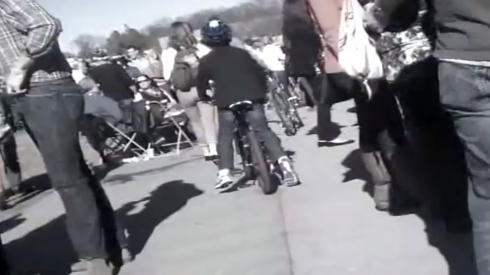I’m trying to post more regularly, but there is so much going on that I can barely find the time. It is a good kind of busy.
Transportation Camp and T.R.B.
I just wrapped up a trip to Washington D.C. to visit TransportationCamp D.C. and the annual meeting of the Transportation Research Board.
TransportationCamp D.C. was an awesome event. It was held at George Mason University’s Arlington campus. TransportationCamp is billed as an un-conference. Basically what that means is that the event is driven by the participants in an ad-hoc fashion. With 400 participants, that is no small order. Surprisingly, everything went really smoothly, even the 400-person introduction to start the day. Quick give your name, affiliation, and a three-word introduction on anything you want. I said, “Make Carefree Easy”. The most entertaining introductions were “I need work” and “We are hiring!”
TransportationCamp was a great place for networking. The un-conference environment made peers of everyone. There was not this default hierarchy that you often find with traditional conferences. At TransportationCamp, leaders from MTA in New York and Google Transit rubbed shoulders with mere grad students such as myself.
The session topics varied widely, from how to design software for paratransit and integrate transit schedule data from multiple agencies, on the technical end of the spectrum, to convincing non-transit users to support transit and instructions on failing a transportation referendum, on the advocacy side of the spectrum. Atlantans are experts at failing referendums.
I am excited for TransportationCamp to head south next month. Saturday, February 9th, TransportationCamp will be at Georgia Tech for the first T.C. in the Southeastern region. I am really looking forward to seeing what sort of crowd shows up (spots are filling up fast). We all know that the South is a special place where innovative transportation and transit is somewhat lacking. The most creative Atlanta tends to get is proposing to double-deck interstate-285 or building a second connector through the Virginia Highland neighborhood. But that sort of shenanigans is on the way out.
The rest of my week was filled with attending the overwhelmingly huge Transportation Research Board Annual Meeting. I could spend days discussing this 11,000+ participant event, but I won’t. I will boil it down to two interesting thoughts.
1) I attended two committee meetings at TRB. The committees at TRB are responsible for reviewing and accepting papers as well as guiding future research in their field. The two meetings I attended were Emerging Technologies in Public Transportation Committee and the Paratransit Committee. What I found interesting is that in BOTH of these totally separate committee meetings, the topic of self-driving cars came up. These committees are curious about the effect of self-driving cars on the role of public transportation and paratransit. As someone who believes that self-driving cars will have a major impact on not only transportation, but also the design of cities and even basic human interaction, it was reassuring to see that people in roles to guide future research were beginning to prepare for the eventual and inevitable arrival of autonomous vehicles. How will our cities adapt to this new paradigm altering technology?
2) I was lucky enough to hear a keynote address from the Secretary of Transportation, Ray LaHood. TRB is a large umbrella organization that covers every conceivable form of transportation, air, water, highway, transit, pedestrian, bicycle, roller blades, hot air balloons, etc. etc. etc. In a room of several hundred distinguished guests that represent every conceivable form of transportation, Ray LaHood chose to spend his time discussing transit, cycling, and pedestrian-friendly cities. It was encouraging. Not that he didn’t spent some time on highways and improving highway safety, but it was obvious that his main motivation was to improve non-car options in the USA.
Small Thoughts on D.C. versus Atlanta
Getting to spend a week in Washington D.C., you really notice some glaring differences between Atlanta and more walkable cities. There are a couple of obvious improvements that Atlanta could make to become much more walkable.
1) Introduces some medium density town homes.
It seems that Atlanta jumps between super dense swanky high rises to straight up sprawl with very little in between. What little there is in between, namely the midtown neighborhood between 10th St., North Avenue, Monroe Dr., and Peachtree Street, is crazy expensive compared to the rest of the city. I can’t afford a million dollar detached home with 1/4 acre yard in midtown Atlanta. Why can’t we make some more town homes and fill in that gap between run-of-the-mill condos and detached homes? Something like the street below should be replicated more often in the neighborhoods adjacent to Peachtree Street. I like urban living, but I also like having my feet on the ground.
A small stretch of town homes in midtown Atlanta.
Washington D.C. is covered with medium density homes. Actually the density is probably too low for that particular city as home prices are through the roof, but I think this type of development would work great in Atlanta.
A typical street in the Dupont Circle neighborhood in Washington D.C.
2) Fix the sprawled out MARTA stations.
Take a look at Arts Center Station below. Transit stations are supposed to be hubs of pedestrian activity. What do you see here? A giant hulking compound with no street facing stores and pedestrian destinations that are unnaturally separated by the sprawling MARTA station. When one leaves the MARTA station there are few shops to enter. Just outside the view of this photo is a pizza shop, hair salon, and apartment complex. Unfortunately, they are not easily accessible from the rail station because of the 5-lane mini interstate that is W. Peachtree street. Also, notice the High museum in the background and the large parking deck to the right side of the picture. There is no pedestrian access noticeable. Despite this being one of a handful of in-town transit stations, everything is car oriented with little thought given to the pedestrian experience. My camera couldn’t even capture the entirety of this MARTA station. Only about half is shown. To the left of this picture is a giant vacant lot devoid of sidewalks or easy cut-thrus for walking. Most of the time that I walk through here, I am not even using MARTA so this giant concrete bunker becomes nothing more than a large impediment. The station actually triples the time that it would take me to reach the High museum from where this picture was taken. C’mon MARTA. I know that this was designed decades ago and now we are stuck with it, but can we not encourage a little development around or even above the station?

Compare the image above with a typical station in D.C. The interior of their stations are just as large as MARTA stations, but the entrances are small and out of the way. Take some time to move around this Street View link. Notice how much development there is directly adjacent to the transit entrance. That is how to do it. Transit stations are sources and sinks for pedestrian traffic. The surrounding areas should be custom built to encourage pedestrian activity and take advantage of their presence.
Atlanta Bicycle Coalition
I finally renewed my membership! It really is a great bang for my buck.
Over the past few years, I have noticed a huge improvement in cycling infrastructure in midtown and downtown Atlanta: new bike lines, sharrows, our first bike signal, etc. etc. I make a small annual donation for membership to ABC and a team of dedicated advocates fight for my rights. What a bargain!

I just want to thank all those people who work hard to get these improvements put into place. I know that metro-Atlanta tends to have a very negative attitude towards any mode of transportation that doesn’t involve at least 4 wheels and 2+ tons of steel. So it is great to have an organization like the Atlanta Bicycle Coalition going out there and fighting for my rights every day.
2013 already has a big list of projects.
Tags: atlanta, Bicycle, MARTA, TransportationCamp, Washington D.C.

































